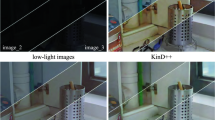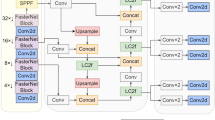Abstract
Underwater images play an irreplaceable role as one of the carriers of underwater information acquisition. Underwater degraded images are usually affected by the color cast, noise, and blurred details, which are difficult to apply to various vision tasks. We propose a multi-scale retinex adaptive grayscale transformation underwater image enhancement method, which includes three parts: color correction, image denoising, and detail enhancement. Firstly, the multi-scale Retinex algorithm is adopted to extract the lighting components. Mean and mean square errors were introduced through linear quantization, and color recovery factors were adopted to adjust the three channels for color correction. Second, by treating the image as an anisotropic thermal field diffusing in all direction,image noise is eliminated and edge details are preserved. Finally, for different underwater degraded images, a simulated annealing optimization algorithm is introduced to perform adaptive gray-scale transformation on the image to enhance image details. The results show that the proposed method can comprehensively solve the problems of color distortion, noise, and low contrast. Compared with the state-of-the-art underwater image enhancement and restoration methods, our method has achieved better visual effects.








Similar content being viewed by others
References
Ancuti C, Ancuti CO, Haber T et al (2012) Enhancing underwater images and videos by fusion. In IEEE conference on computer vision and pattern recognition pp 81–88
Ancuti CO, Ancuti C, De Vleeschouwer C, Bekaert P (2017) Color balance and fusion for underwater image enhancement. IEEE Trans Image Process 27(1):379–393
Anwar S, Li C (2020) Diving deeper into underwater image enhancement: a survey. Signal Process Image Commun 89:115978
Artyukov IA, Irtuganov NN (2019) Noise-driven anisotropic diffusion filtering for x-ray low contrast imaging. J Russ Laser Res 40(2):150–154
Barnard K (1999) Practical color constancy. PhD Thesis Simon Fraser University, School of Computing
Buchsbaum G (1980) A spatial processor model for object colour perception. J Franklin Inst 310(1):1–26
Chen Y, Lin J, Zhang S, Chen C (20109) Image hiding algorithm based on block random scrambling and grayscale transformation. In 2010 international conference on display and photonics, vol 7749, pp 77490Y
Cong R, Zhang Y, Zhang C, Li C, Zhao Y (2020) Research progress of deep learning driven underwater image enhancement and restoration. J Signal Process 36(9):1377–1389
Deng L, Zhu H, Yang Z, Li Y (2019) Hessian matrix-based fourth-order anisotropic diffusion filter for image denoising. Opt Laser Technol 110:184–190
Drews P, Nascimento E, Moraes F, Botelho S, Campos M (2013) Transmission estimation in underwater single image. In proceedings of the IEEE international conference on computer vision workshops pp 825–830
Drews PL, Nascimento ER, Botelho SS, Campos MFM (2016) Underwater depth estimation and image restoration based on single images. IEEE Comput Graph Appl 36(2):24–35
Fabbri C, Islam MJ, Sattar J (2018) Enhancing underwater imagery using generative adversarial networks. In IEEE international conference on robotics and automation (ICRA) pp 7159–7165
Fu X, Fan Z, Ling M, Huang Y, Ding X (2017) Two-step approach for single underwater image enhancement. In 2017 international symposium on intelligent signal processing and communication systems pp 789–794
Fu X, Zhuang P, Huang Y, Liao Y, Zhang XP, Ding X (2014) A retinex-based enhancing approach for single underwater image. In 2014 IEEE international conference on image processing (ICIP) pp 4572–4576
Guo F, Zhang G, Zhang Q, Zhao R, Deng M, Xu K, Jia P, Hao X (2019) Fusion despeckling based on surface variation anisotropic diffusion filter and ratio image filter. IEEE Trans Geoence Remote Sens 58(4):2398–2411
Guo P, Zeng D, Tian Y, Liu S, Liu H, Li D (2020) Multi-scale enhancement fusion for underwater sea cucumber images based on human visual system modelling. Comput Electron Agric 175:105608
Guo Y, Li H, Zhuang P (2019) Underwater image enhancement using a multiscale dense generative adversarial network. IEEE J Ocean Eng 45(3):862–870
Han M, Lyu Z, Qiu T et al (2020) A review on intelligence dehazing and color restoration for underwater images. IEEE Trans Systems Man Cybern Syst 50(5):1820–1832
Hautiere N, Tarel JP, Aubert D, Dumont E (2008) Blind contrast enhancement assessment by gradient ratioing at visible edges. Image Anal Stereol 27(2):87–95
He K, Sun J, Tang X (2010) Single image haze removal using dark channel prior. IEEE Trans Pattern Anal Mach Intell 33(12):2341–2353
Hummel R (1977) Image enhancement by histogram transformation. Comput Graph Image Proc 6(2):184–195
Hussain DM, Surendran D (2020) Content based image retrieval using bees algorithm and simulated annealing approach in medical big data applications. Multimed Tools Appl 79(5):3683–3698
Iqbal K, Odetayo M, James A, Salam RA, Talib AZH (2010) Enhancing the low quality images using unsupervised colour correction method. In 2010 IEEE International Conference on Systems, Man and Cybernetics pp 1703–1709
Iqbal K, Salam RA, Osman A, Talib AZ (2007) Underwater image enhancement using an integrated colour model. IAENG Int J Comput Sci 34(2):239–244
Jobson DJ, Rahman Z, Woodell GA (1997) Properties and performance of a center/surround retinex. IEEE Trans Image Process 6(3):451–462
Kim JH, Jang WD, Sim JY, Kim CS (2013) Optimized contrast enhancement for real-time image and video dehazing. J Vis Commun Image Represent 24(3):410–425
Kim TK, Paik JK, Kang BS (1988) Contrast enhancement system using spatially adaptive histogram equalization with temporal filtering. IEEE Trans Consum Electron 44(1):82–87
Kirkpatrick S, Gelatt CD, Vecchi MP (1983) Optimization by simulated annealing. Science 220(4598):671–680
Lee HS, Moon SW, Eom IK (2020) Underwater image enhancement using successive color correction and superpixel dark channel prior. Symmetry 12(8):1220
Lowe DG (2004) Distinctive image features from scale-invariant keypoints. Int J Comput Vis 60(2):91–110
Li CY, Guo JC, Cong RM et al (2016) Underwater image enhancement by dehazing with minimum information loss and histogram distribution prior. IEEE Trans Image Process 25(12):5664–5677
Li C, Guo J, Guo C, Cong R, Gong J (2017) A hybrid method for underwater image correction. Pattern Recogn Lett 94:62–67
Li C, Guo J, Guo C (2018) Emerging from water: underwater image color correction based on weakly supervised color transfer. IEEE Signal Process Lett 25(3):323–327
Li C, Guo C, Ren W, Cong R, Hou J, Kwong S, Tao D (2020) An underwater image enhancement benchmark dataset and beyond. IEEE Trans Image Process 29:4376–4389
Li J, Skinner KA, Eustice RM, Johnson-Roberson M (2017) WaterGAN: unsupervised generative network to enable real-time color correction of monocular underwater images. IEEE Robot Autom lett 3(1):387–394
Lu H, Li Y, Zhang Y et al (2017) Underwater optical image processing: a comprehensive review. Mob Netw Appl 22(6):1204–1211
Panetta K, Gao C, Agaian S (2015) Human-visual-system-inspired underwater image quality measures. IEEE J Ocean Eng 41(3):541–551
Parthasarathy S, Sankaran P (2012) An automated multi scale retinex with color restoration for image enhancement. In 2012 national conference on communications (NCC) pp 1–5
Peng YT, Cosman PC (2017) Underwater image restoration based on image blurriness and light absorption. IEEE Trans Image Process 26(4):1579–1594
Perona P, Malik J (1990) Scale-space and edge detection using anisotropic diffusion. IEEE Trans Pattern Anal Mach Intell 12(7):629–639
Rahman ZU, Jobson DJ, Woodell GA (1996) Multi-scale retinex for color image enhancement. In Proceedings of 3rd ieee international conference on image processing vol 3, pp 1003–1006
Ren W, Liu S, Ma L, Xu Q, Xu X, Cao X, Du J, Yang MH (2019) Low-light image enhancement via a deep hybrid network. IEEE Trans Image Process 28(9):4364–4375
Ren W, Pan J, Zhang H et al (2020) Single image dehazing via multi-scale convolutional neural networks with holistic edges. Int J Comput Vis 128(1):240–259
Ren W, Zhang J, Xu X, Ma L, Cao X, Meng G, Liu W (2018) Deep video dehazing with semantic segmentation. IEEE Trans Image Process 28(4):1895–1908
Roser M, Dunbabin M, Geiger A (2014) Simultaneous underwater visibility assessment, enhancement and improved stereo. In IEEE international conference on robotics and automation (ICRA) pp 3840–3847
Sankpal SS, Deshpande SS (2016) A review on image enhancement and color correction techniques for underwater images. Adv Comput Sci Technol 9(1):11–23
Schechner YY, Karpel N (2005) Recovery of underwater visibility and structure by polarization analysis. IEEE J Ocean Eng 30(3):570–587
Song W, Wang Y, Huang D, Tjondronegoro D (2018) A rapid scene depth estimation model based on underwater light attenuation prior for underwater image restoration. Pacific Rim Conf Multimed 11164:678–688
Tan CS, Seet G, Sluzek A et al (2005) A novel application of range-gated underwater laser imaging system (ULIS) in near-target turbid medium. Opt Lasers Eng 43(9):995–1009
Tang C, von Lukas UF, Vahl M, Wang S, Wang Y, Tan M (2019) Efficient underwater image and video enhancement based on retinex. Signal Image Video Process 13(5):1011–1018
Tang JR, Isa NAM (2017) Bi-histogram equalization using modified histogram bins. Appl Soft Comput 55:31–43
Wang J, Lu K, Xue J, He N, Shao L (2018) Single image dehazing based on the physical model and MSRCR algorithm. IEEE Trans Circ Syst Video Technol 28(9):2190–2199
Wang Y, Song W, Fortino G et al (2019) An experimental-based review of image enhancement and image restoration methods for underwater imaging. IEEE Access 7:140233–140251
Weickert J (1996) Theoretical foundations of anisotropic diffusion in image processing. Theor Found Comput Vis 221–236
Wen H, Tian Y, Huang T, Gao W (2013) Single underwater image enhancement with a new optical model. In 2013 IEEE international symposium on circuits and systems (ISCAS2013) pp 753–756
Weng CC, Chen H, Fuh CS (2005) A novel automatic white balance method for digital still cameras. In IEEE international symposium on circuits and systems (ISCAS) pp 3801–3804
Xia H, Liu M (2019) Non-uniform illumination image enhancement based on retinex and gamma correction. J Phys Conf Ser 1213(5):052072
Yang M, Hu J, Li C et al (2019) An in-depth survey of underwater image enhancement and restoration. IEEE Access 7:123638–123657
Yang M, Sowmya A (2015) An underwater color image quality evaluation metric. IEEE Trans Image Process 24(12):6062–6071
Yang M, Sowmya A, Wei Z, Zheng B (2019) Offshore underwater image restoration using reflection-decomposition-based transmission map estimation. IEEE J Ocean Eng 45(2):521–533
Zhang K, Jin WQ, Su Q, Wang X (2011) Multi-scale retinex enhancement algorithm on luminance channel of color underwater image. Infrared Technol 33(11):630–634
Zhishen L, Tianfu D, Gang W (2003) ROV based underwater blurred image restoration. J Ocean Univ Qingdao 2(1):85–88
Zhang S, Wang T, Dong J, Yu H (2017) Underwater image enhancement via extended multi-scale retinex. Neurocomputing 245:1–9
Zhou J, Zhang D, Zhang W (2020) Classical and state-of-the-art approaches for underwater image defogging: a comprehensive survey. Front Inform Technol Elect Eng 21(5):1745–1769
Zhou J, Zhang D, Zou P, Zhang W, Zhang W (2019) Retinex-based laplacian pyramid method for image defogging. IEEE Access 7:122459–122472
Zhuang P, Ding X (2020) Underwater image enhancement using an edge-preserving filtering Retinex algorithm. Multimed Tools Appl 1–21
Zhou Y, Wu Q, Yan K et al (2018) Underwater image restoration using color-line model. IEEE Trans Circuits Syst Video Technol 29(3):907–911
Acknowledgements
This work was supported by the National Natural Science Foundation of China (No. 61702074), the Liaoning Provincial Natural Science Foundation of China (No. 20170520196), and the Fundamental Research Funds for the Central Universities (Nos.3132019205 and 3132019354).
Author information
Authors and Affiliations
Corresponding authors
Ethics declarations
Conflicts of interest
The authors declare no conflict of interest.
Additional information
Publisher's Note
Springer Nature remains neutral with regard to jurisdictional claims in published maps and institutional affiliations.
Rights and permissions
About this article
Cite this article
Zhou, J., Yao, J., Zhang, W. et al. Multi-scale retinex-based adaptive gray-scale transformation method for underwater image enhancement. Multimed Tools Appl 81, 1811–1831 (2022). https://doi.org/10.1007/s11042-021-11327-8
Received:
Revised:
Accepted:
Published:
Issue Date:
DOI: https://doi.org/10.1007/s11042-021-11327-8




